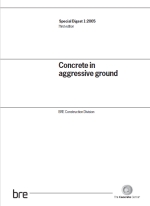Concrete in aggressive ground (SD 1)
BRE (Building Research Establishment) is an independent, research-based consultancy, testing and training organisation, operating in the built environment and associated industries.
On 12 June 2005, BRE published, Concrete in aggressive ground (SD 1), written by the BRE Construction Division.
Chemical agents found in the ground can destroy concrete. In the UK, these agents are most commonly sulfates and acids that occur naturally in soil and groundwater, and can cause the expansion and softening of concrete. Other substances, most resulting from human activity, can be aggressive but present less of a problem as they only rarely come into contact with concrete.
The 2005 edition of BRE Special Digest 1 (SD1:2005) simplifies, updates and consolidates Parts 1 to 4 of the previous edition published in 2003. It was revised to reflect new thinking and changes to the British Standards, including:
- A new ranking of cements in relation to sulfate resistance.
- Removal of the aggregate carbonate range.
- Revision of sulfate class limits.
- Simpler requirements for additional protective measures.
It provides guidance on the specification of concrete for installation in natural ground and brownfield sites. The procedures for ground assessment and concrete specification cover the common occurrence of sulfates, sulfides and acids as well as the more rarely occurring aggressive carbon dioxide found in some ground and surface waters. It is intended to provide practical guidance for ground specialists as well as specification advise for concrete designers, specifiers and producers.
It is presented in 6 parts:
- Part A: Introduces the chemical attack of concrete in the ground.
- Part B: Describes modes of chemical attack and discusses the principal types.
- Part C: Deals with the assessment of the chemical aggressiveness of the ground.
- Part D: Gives recommendations for the specification of concrete for general cast-in-situ use.
- Part E: Gives recommendations for specifying surface carbonated precast concrete for general use.
- Part F: Includes design guides for the specification of precast concrete products.
[edit] Find out more
[edit] Related articles on Designing Buildings Wiki.
- Alkali-activated binder.
- Alkali-aggregate reaction (AAR).
- Architectural concrete.
- BRE articles on Designing Buildings Wiki.
- Brownfield land.
- Building Research Establishment.
- Cellular concrete.
- Concrete.
- Concrete-steel composite structures.
- Concrete repair mortars.
- Concrete superplasticizer.
- Concreting plant.
- Contaminated land.
- Efflorescence.
- Formwork.
- Ground investigation.
- Hempcrete.
- Precast concrete.
- Prestressed concrete.
- Reinforced concrete.
- Self-compacting concrete.
- Testing concrete.
- The properties of concrete.
Featured articles and news
The UK's Modern Industrial Strategy: A 10 year plan
Previous consultation criticism, current key elements and general support with some persisting reservations.
Building Safety Regulator reforms
New roles, new staff and a new fast track service pave the way for a single construction regulator.
Architectural Technologist CPDs and Communications
CIAT CPD… and how you can do it!
Cooling centres and cool spaces
Managing extreme heat in cities by directing the public to places for heat stress relief and water sources.
Winter gardens: A brief history and warm variations
Extending the season with glass in different forms and terms.
Restoring Great Yarmouth's Winter Gardens
Transforming one of the least sustainable constructions imaginable.
Construction Skills Mission Board launch sector drive
Newly formed government and industry collaboration set strategy for recruiting an additional 100,000 construction workers a year.
New Architects Code comes into effect in September 2025
ARB Architects Code of Conduct and Practice available with ongoing consultation regarding guidance.
Welsh Skills Body (Medr) launches ambitious plan
The new skills body brings together funding and regulation of tertiary education and research for the devolved nation.
Paul Gandy FCIOB announced as next CIOB President
Former Tilbury Douglas CEO takes helm.
UK Infrastructure: A 10 Year Strategy. In brief with reactions
With the National Infrastructure and Service Transformation Authority (NISTA).
Ebenezer Howard: inventor of the garden city. Book review.
The Grenfell Tower fire, eight years on
A time to pause and reflect as Dubai tower block fire reported just before anniversary.
Airtightness Topic Guide BSRIA TG 27/2025
Explaining the basics of airtightness, what it is, why it's important, when it's required and how it's carried out.
Construction contract awards hit lowest point of 2025
Plummeting for second consecutive month, intensifying concerns for housing and infrastructure goals.
Understanding Mental Health in the Built Environment 2025
Examining the state of mental health in construction, shedding light on levels of stress, anxiety and depression.























